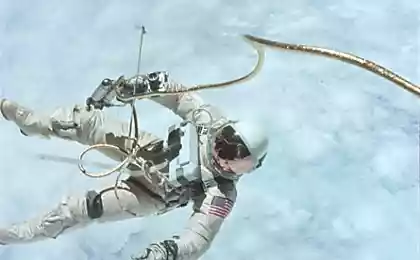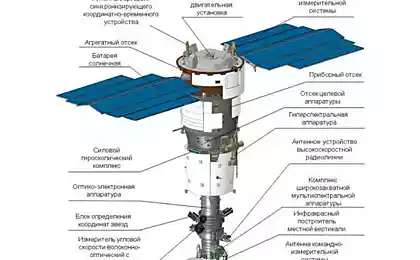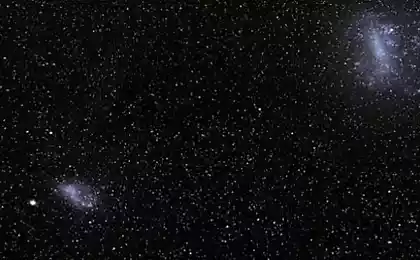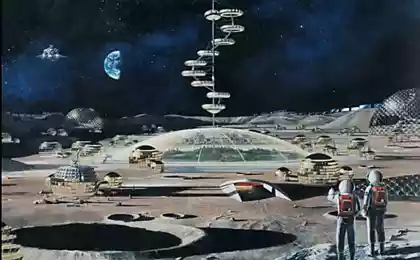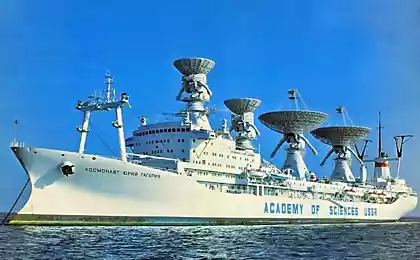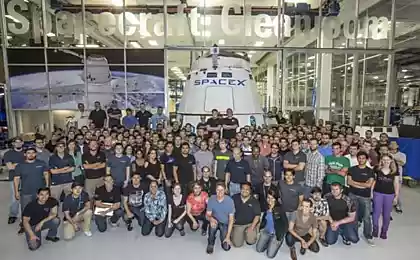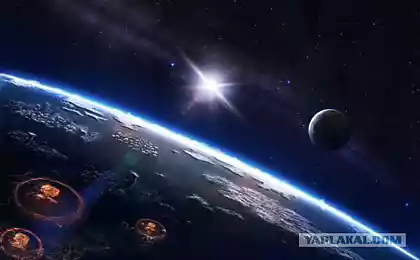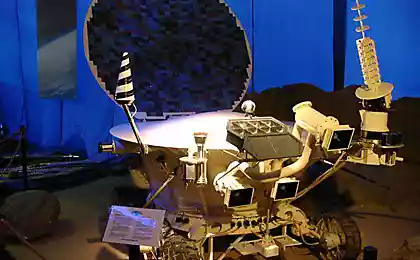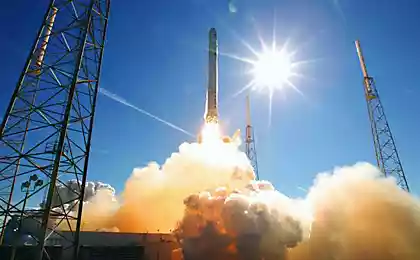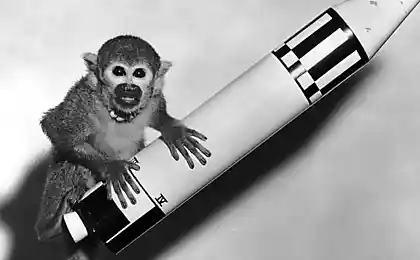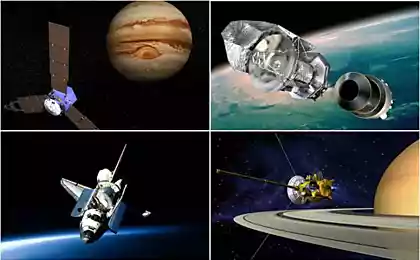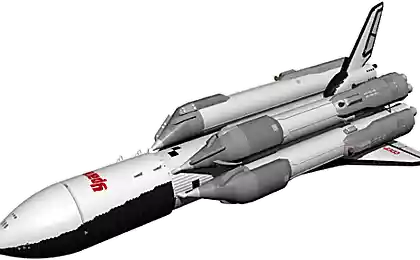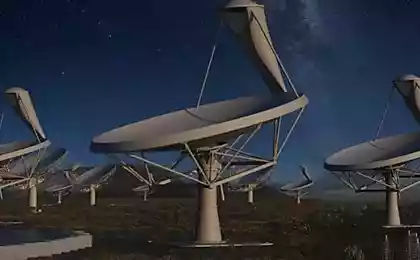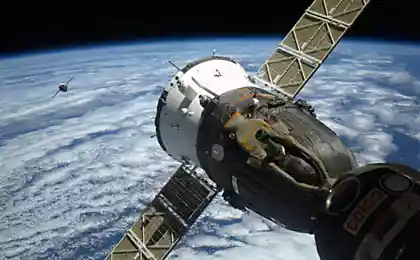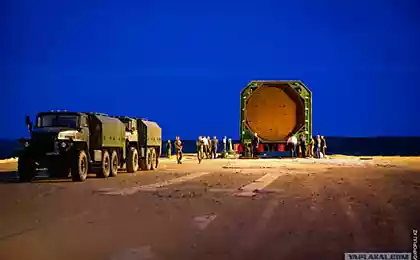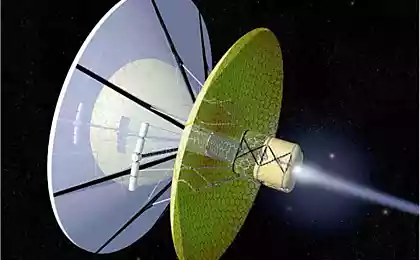849
Top 10 space photographs
2013 comes to an end, and for the past eleven months we were able to see a lot of beautiful pictures. It so happened historically that the most exciting images for all of us - it is the image of the cosmos, cosmic bodies, the Earth and other planets of the solar system. At the moment, there is no way to look beyond the atmosphere and see firsthand how beautiful space, if you're not an astronaut. Unless admire other people's photos and they believe in the word.
Here is a dozen of the most spectacular images of the cosmos, we paid attention to in 2013.
10. The center of the Milky Way
Photo: Hubble
The galaxy, according to various estimates, from 100 to 150 billion stars. One of these stars is our native sun, feed our Earth and consistently getting up in the East for many millions of years. Space Telescope "Hubble" managed to take a picture of the center of our Milky Way galaxy. The image was taken through infrared light that can pass through the thick layers of dust and gas, almost without distorting the image.
According to scientists, in the center of the Milky Way still remains an object that failed to capture. Most likely, the reason lies in the fact that Alfa Sagittarius (Sagittarius A *) managed to elude observation, because it is a supermassive black hole. A black hole distorts the light of the more than more of their weight. Photo center of the Milky Way has allowed a glimpse into the heart of our galaxy, revealing to us an indescribable spectacle of the stars that we may have to visit.
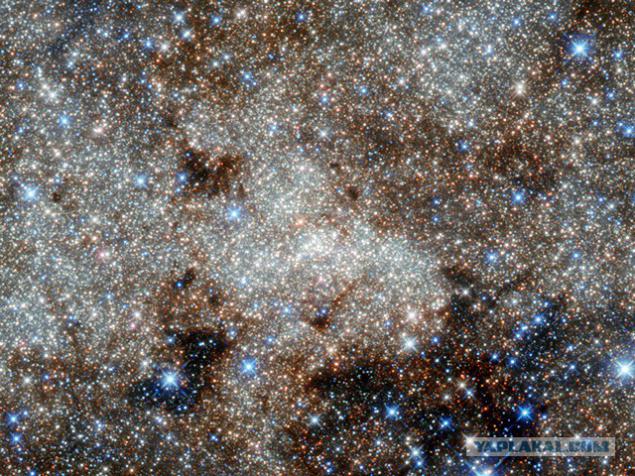
9. The surface of Venus
Snapshot: station "Magellan»
For a long time, the surface of Venus was hidden from the curiosity of researchers of the earth. Incredibly carefully guarded its thick clouds of sulfuric acid with a high degree of reflection. In addition, the majority of probes that landed on the surface of Venus, is simply burned in her poisonous and extremely unfriendly atmosphere. Those few who still managed to "priveneritsya" were not able to rise. Due to the lack of knowledge of what is going on behind the thick Venusian clouds, NASA even planned flight to the "morning star».
Relief Venus managed to capture through the airwaves. Interplanetary station NASA «Magellan" for four years (1990-1994) revolved around Venus collecting full radar map of the planet. The image was simulated on the basis of data obtained from "Magellan". The picture and the previous data on the quality of the surface of Venus finally put an end to hopes to master the planet - under these circumstances it is almost impossible. Although plans are still terraformed.

8. Tail of our solar system
Snapshot: NASA IBEX
For a long time astronomers have guessed suspected, but did not know for sure that that the solar system has a tail. You should know that we, including the planets, the sun and other celestial bodies move through the galaxy as it, in turn, moves through the universe.
The so-called geliohvost formed by advancing the solar system through space. The particles that make up geliohvost not lit, so capture them was difficult. For this IBEX (Interstellar Boundary Explorer, researcher interstellar boundaries) I used the camera to record the energy of neutral atoms and captured neutral particles, which were formed by the collision of atoms and particles on the boundary of the heliosphere. What was the result - you can watch with pleasure.
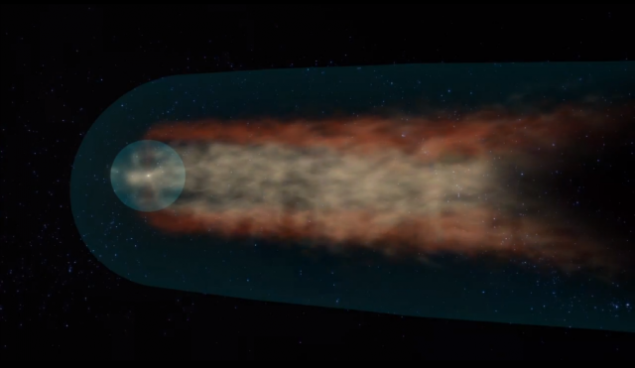
7. Sea and the north pole of Titan's lakes
Snapshot: probe "Cassini»
Titan - one of the most mysterious bodies in our solar system. The surface of Saturn's moon is covered with methane as well as the Earth is covered by water. The first space probe "Cassini", which explores the Saturn and its moons, so managed to get clear pictures of the northern lakes.
"We are fortunate that, after nine years with the arrival of the" Cassini "in Saturn's North Pole of Titan began to fall into the sun's rays, which were previously hidden from us the shaded area," - explained in the NASA ».
The scientific community believes that the Titan can not only keep the life in the bud, as it was a long time ago on Earth, but also to shed light on its origin and development in the solar system.
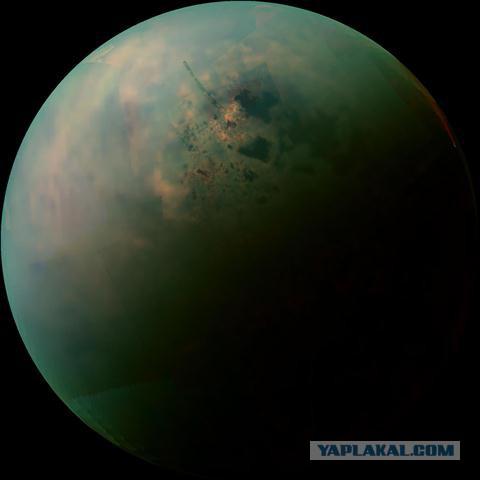
6. View from space on the northern lights
Photo: Mike Hopkins, ISS
This photo Mike Hopkins, one of the astronauts to the ISS, shared on his page on Instagram. The picture was taken a few days before the agency NASA has been temporarily closed, and published immediately after the resumption of its work. The sun, which are responsible for the manifestation of the Northern Lights, is now at the peak of its 11-year activity cycle, although it is the weakest cycle in the history of space exploration. Many would give a lot (sorry for tautology) in order to look at the aurora borealis in the north (and sorry again) with my own eyes. But the view from space is a manifestation of Earth's magnetic field offers all the space.
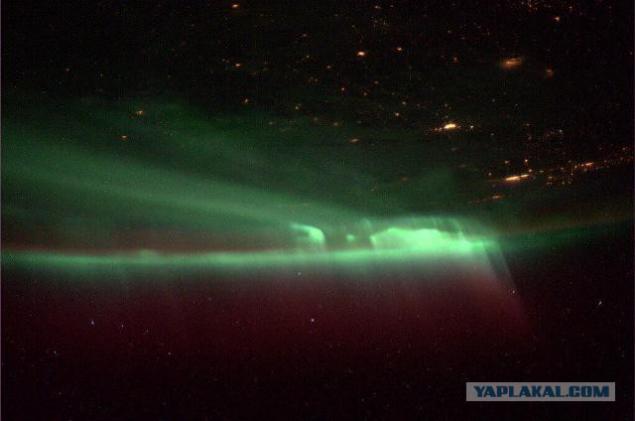
5. Mars in youth
Image: Kevin Gill
Software Engineer Kevin Gill, who ate a dog in the creation of virtual models depicted Mars as it might have been in the past. Modern rover finds "Kyuriositi" showed that a long time ago water flowed on Mars and has a dense atmosphere. In the picture there is a red dusty surface on which idly rover creeps, but on the contrary - the ocean and the mountains, volcanoes and atmosphere. A striking resemblance to our native "blue ball».
The image shows a giant ocean on one side of the planet, which resulted in the Valles Marineris (Valles Marineris) length of about three kilometers. Gill also showed volcanic peaks Pavonis Mons, Ascreaus Mons, Arsia Mons, and the largest in the solar system, Olympus Mons, to break through the Martian atmosphere. All of them are located on the plateau of volcanic Tharsis Bulge and even after terraforming probably remain the only brown and dry-looking objects of Mars.

4. Mimas and Pandora in the background of the rings of Saturn
Snapshot: probe "Cassini»
Another photo of the probe "Cassini" hit the top 10. In the picture shows a Pandora - a small moon of Saturn, literally stretched his huge attraction, and Mimas, which appears on the background of a giant Pandora. The lower part of the photo-cross the icy gas giant Saturn's rings. Total around the planet turns 62 natural satellites, of which only 53 have received official names.
That is curious: would the people an opportunity to visit Saturn's moons as the tourist sites? The choice is big enough. Fly, however, dolgovato, but this problem can be solved with time.
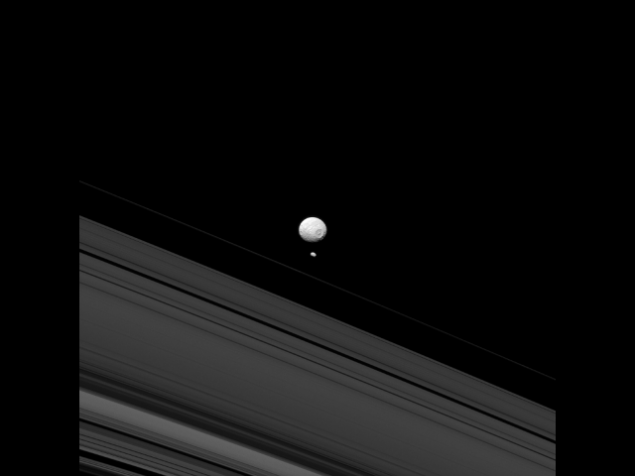
3. Trail "Kyuriositi»
Snapshot: NASA MRO
Almost half a year has passed since the NASA rover with a proud name "Curiosity" landed on the Martian surface. In July, the space agency has decided to share with the public image, which shows the entire path of the rover. Yes there is shown - the trail that passed "Kyuriositi", seen in the picture and without markers. The only useful tip - white and blue dot in the bottom right of the picture - a hero of the occasion himself.
The image was taken multifunctional automatic interplanetary station Mars Reconnaissance Orbiter with the camera HiRISE (High Resolution Imaging Science Experiment), using a reflecting telescope with a diameter of 0, 5 meters. The camera provides outstanding experts NASA imagery of the Red Planet since 2006.
Place the rover landing "Kyuriositi" is indicated by two blue dots and different markings. Rate it away in the picture is very difficult, but for the space agency says that the track width is 3 meters.
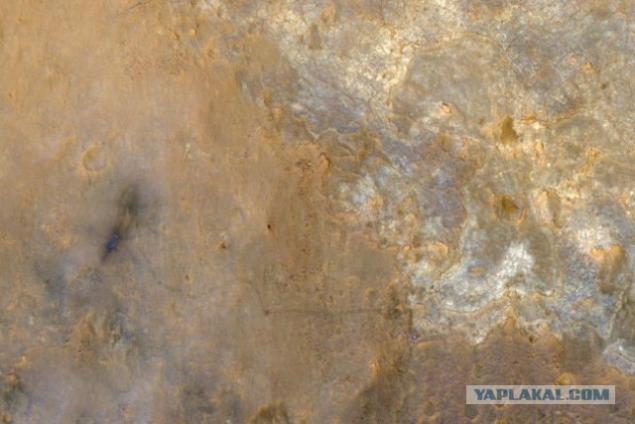
2. Land on the background of the rings of Saturn
Snapshot: probe "Cassini»
And one of the famous picture by the probe - Earth on the background of the rings of Saturn. It is worth noting that this is only the third picture in the history, in which the Earth captured from the outer solar system - it is a small blue dot. The first two images were made by launching into orbit of Mercury interplanetary station "Messenger" and probe "Voyager 1". Parallel "little blue dot" is obvious: a shot that sent the "Voyager 1" at the time (pale blue dot) shook the earth community observers.
The farther away from the Earth at the point represented the birthplace of human rights. I agree and Linda Spilker, a member of the "Cassini" and a member of the Jet Propulsion Laboratory NASA. She also noted that the image is once again reminds mankind of how small the Earth is in the wilds of unknown space, as well as evidence of the ingenuity of the inhabitants of this tiny planet, are the creators of these spacecraft, which under force to make discoveries of this kind.
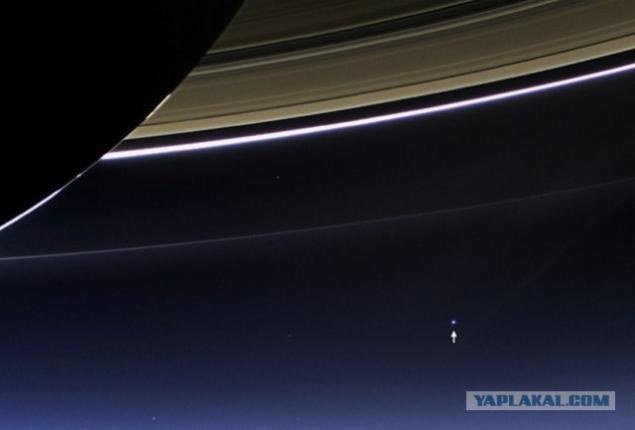
1. Map of the Earth's celestial threats
NASA
Space agency NASA is watching closely and carefully classify all potentially hazardous objects that may threaten, to a greater or lesser extent, the existence of the Earth and humanity. Currently, the catalog of objects VET already in 1397 and it is constantly updated (though not as fast as before).
In August, NASA has made a map of the trajectory of movement of all potentially hazardous to Earth bodies under surveillance. Now we do not profukali the most epic moment, but how much of it will be joy - hard to say. If the distance of one of these facilities to our Earth is less than 7, 4 million kilometers, while its size in diameter is more than 100 meters - you can be sure that NASA him constantly monitors.
I hope you liked it. All
hi-news.ru
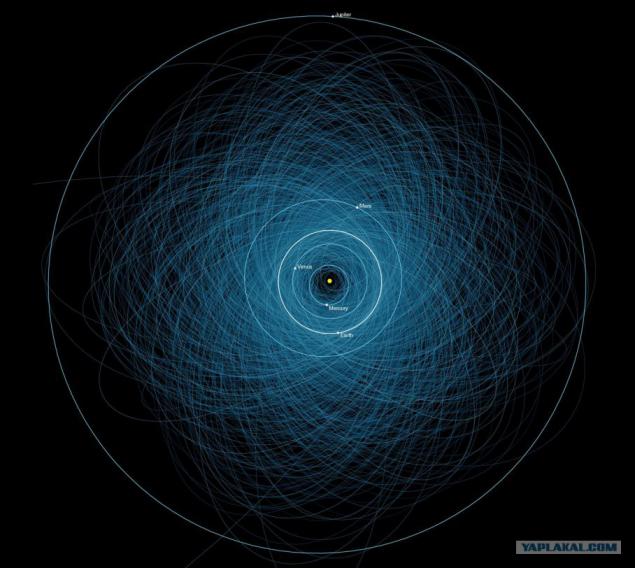
Source:
Here is a dozen of the most spectacular images of the cosmos, we paid attention to in 2013.
10. The center of the Milky Way
Photo: Hubble
The galaxy, according to various estimates, from 100 to 150 billion stars. One of these stars is our native sun, feed our Earth and consistently getting up in the East for many millions of years. Space Telescope "Hubble" managed to take a picture of the center of our Milky Way galaxy. The image was taken through infrared light that can pass through the thick layers of dust and gas, almost without distorting the image.
According to scientists, in the center of the Milky Way still remains an object that failed to capture. Most likely, the reason lies in the fact that Alfa Sagittarius (Sagittarius A *) managed to elude observation, because it is a supermassive black hole. A black hole distorts the light of the more than more of their weight. Photo center of the Milky Way has allowed a glimpse into the heart of our galaxy, revealing to us an indescribable spectacle of the stars that we may have to visit.

9. The surface of Venus
Snapshot: station "Magellan»
For a long time, the surface of Venus was hidden from the curiosity of researchers of the earth. Incredibly carefully guarded its thick clouds of sulfuric acid with a high degree of reflection. In addition, the majority of probes that landed on the surface of Venus, is simply burned in her poisonous and extremely unfriendly atmosphere. Those few who still managed to "priveneritsya" were not able to rise. Due to the lack of knowledge of what is going on behind the thick Venusian clouds, NASA even planned flight to the "morning star».
Relief Venus managed to capture through the airwaves. Interplanetary station NASA «Magellan" for four years (1990-1994) revolved around Venus collecting full radar map of the planet. The image was simulated on the basis of data obtained from "Magellan". The picture and the previous data on the quality of the surface of Venus finally put an end to hopes to master the planet - under these circumstances it is almost impossible. Although plans are still terraformed.

8. Tail of our solar system
Snapshot: NASA IBEX
For a long time astronomers have guessed suspected, but did not know for sure that that the solar system has a tail. You should know that we, including the planets, the sun and other celestial bodies move through the galaxy as it, in turn, moves through the universe.
The so-called geliohvost formed by advancing the solar system through space. The particles that make up geliohvost not lit, so capture them was difficult. For this IBEX (Interstellar Boundary Explorer, researcher interstellar boundaries) I used the camera to record the energy of neutral atoms and captured neutral particles, which were formed by the collision of atoms and particles on the boundary of the heliosphere. What was the result - you can watch with pleasure.

7. Sea and the north pole of Titan's lakes
Snapshot: probe "Cassini»
Titan - one of the most mysterious bodies in our solar system. The surface of Saturn's moon is covered with methane as well as the Earth is covered by water. The first space probe "Cassini", which explores the Saturn and its moons, so managed to get clear pictures of the northern lakes.
"We are fortunate that, after nine years with the arrival of the" Cassini "in Saturn's North Pole of Titan began to fall into the sun's rays, which were previously hidden from us the shaded area," - explained in the NASA ».
The scientific community believes that the Titan can not only keep the life in the bud, as it was a long time ago on Earth, but also to shed light on its origin and development in the solar system.

6. View from space on the northern lights
Photo: Mike Hopkins, ISS
This photo Mike Hopkins, one of the astronauts to the ISS, shared on his page on Instagram. The picture was taken a few days before the agency NASA has been temporarily closed, and published immediately after the resumption of its work. The sun, which are responsible for the manifestation of the Northern Lights, is now at the peak of its 11-year activity cycle, although it is the weakest cycle in the history of space exploration. Many would give a lot (sorry for tautology) in order to look at the aurora borealis in the north (and sorry again) with my own eyes. But the view from space is a manifestation of Earth's magnetic field offers all the space.

5. Mars in youth
Image: Kevin Gill
Software Engineer Kevin Gill, who ate a dog in the creation of virtual models depicted Mars as it might have been in the past. Modern rover finds "Kyuriositi" showed that a long time ago water flowed on Mars and has a dense atmosphere. In the picture there is a red dusty surface on which idly rover creeps, but on the contrary - the ocean and the mountains, volcanoes and atmosphere. A striking resemblance to our native "blue ball».
The image shows a giant ocean on one side of the planet, which resulted in the Valles Marineris (Valles Marineris) length of about three kilometers. Gill also showed volcanic peaks Pavonis Mons, Ascreaus Mons, Arsia Mons, and the largest in the solar system, Olympus Mons, to break through the Martian atmosphere. All of them are located on the plateau of volcanic Tharsis Bulge and even after terraforming probably remain the only brown and dry-looking objects of Mars.

4. Mimas and Pandora in the background of the rings of Saturn
Snapshot: probe "Cassini»
Another photo of the probe "Cassini" hit the top 10. In the picture shows a Pandora - a small moon of Saturn, literally stretched his huge attraction, and Mimas, which appears on the background of a giant Pandora. The lower part of the photo-cross the icy gas giant Saturn's rings. Total around the planet turns 62 natural satellites, of which only 53 have received official names.
That is curious: would the people an opportunity to visit Saturn's moons as the tourist sites? The choice is big enough. Fly, however, dolgovato, but this problem can be solved with time.

3. Trail "Kyuriositi»
Snapshot: NASA MRO
Almost half a year has passed since the NASA rover with a proud name "Curiosity" landed on the Martian surface. In July, the space agency has decided to share with the public image, which shows the entire path of the rover. Yes there is shown - the trail that passed "Kyuriositi", seen in the picture and without markers. The only useful tip - white and blue dot in the bottom right of the picture - a hero of the occasion himself.
The image was taken multifunctional automatic interplanetary station Mars Reconnaissance Orbiter with the camera HiRISE (High Resolution Imaging Science Experiment), using a reflecting telescope with a diameter of 0, 5 meters. The camera provides outstanding experts NASA imagery of the Red Planet since 2006.
Place the rover landing "Kyuriositi" is indicated by two blue dots and different markings. Rate it away in the picture is very difficult, but for the space agency says that the track width is 3 meters.

2. Land on the background of the rings of Saturn
Snapshot: probe "Cassini»
And one of the famous picture by the probe - Earth on the background of the rings of Saturn. It is worth noting that this is only the third picture in the history, in which the Earth captured from the outer solar system - it is a small blue dot. The first two images were made by launching into orbit of Mercury interplanetary station "Messenger" and probe "Voyager 1". Parallel "little blue dot" is obvious: a shot that sent the "Voyager 1" at the time (pale blue dot) shook the earth community observers.
The farther away from the Earth at the point represented the birthplace of human rights. I agree and Linda Spilker, a member of the "Cassini" and a member of the Jet Propulsion Laboratory NASA. She also noted that the image is once again reminds mankind of how small the Earth is in the wilds of unknown space, as well as evidence of the ingenuity of the inhabitants of this tiny planet, are the creators of these spacecraft, which under force to make discoveries of this kind.

1. Map of the Earth's celestial threats
NASA
Space agency NASA is watching closely and carefully classify all potentially hazardous objects that may threaten, to a greater or lesser extent, the existence of the Earth and humanity. Currently, the catalog of objects VET already in 1397 and it is constantly updated (though not as fast as before).
In August, NASA has made a map of the trajectory of movement of all potentially hazardous to Earth bodies under surveillance. Now we do not profukali the most epic moment, but how much of it will be joy - hard to say. If the distance of one of these facilities to our Earth is less than 7, 4 million kilometers, while its size in diameter is more than 100 meters - you can be sure that NASA him constantly monitors.
I hope you liked it. All
hi-news.ru

Source:

